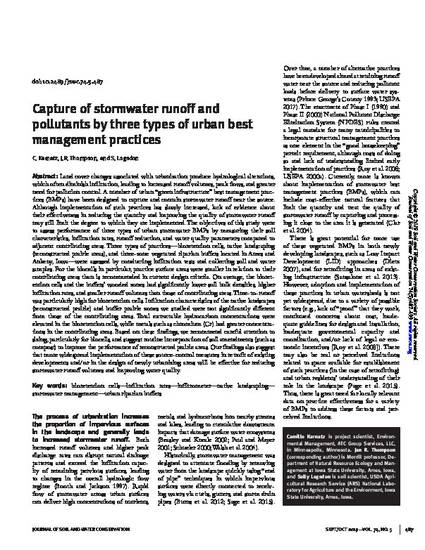
Land cover changes associated with urbanization produce hydrological alterations, which often diminish infiltration, leading to increased runoff volumes, peak flows, and greater need for pollution control. A number of urban “green infrastructure” best management practices (BMPs) have been designed to capture and contain stormwater runoff near the source. Although implementation of such practices has slowly increased, lack of evidence about their effectiveness in reducing the quantity and improving the quality of stormwater runoff may still limit the degree to which they are implemented. The objectives of this study were to assess performance of three types of urban stormwater BMPs by measuring their soil characteristics, infiltration rates, runoff reduction, and water quality parameters compared to adjacent contributing areas. Three types of practices—bioretention cells, native landscaping (reconstructed prairie areas), and three-zone vegetated riparian buffers located in Ames and Ankeny, Iowa—were assessed by conducting infiltration tests and collecting soil and water samples. For the biocells in particular, practice surface areas were smaller in relation to their contributing areas than is recommended in current design criteria. On average, the bioretention cells and the buffers' wooded zones had significantly lower soil bulk densities, higher infiltration rates, and smaller runoff volumes than those of contributing areas. Time-to-runoff was particularly high for bioretention cells. Infiltration characteristics of the native landscapes (reconstructed prairie) and buffer prairie zones we studied were not significantly different from those of the contributing areas. Total extractable hydrocarbon concentrations were elevated in the bioretention cells, while metals such as chromium (Cr) had greater concentrations in the contributing areas. Based on these findings, we recommend careful attention to sizing, particularly for biocells, and suggest routine incorporation of soil amendments (such as compost) to improve the performance of reconstructed prairie areas. Our findings also suggest that more widespread implementation of these source-control measures in retrofit of existing developments and/or in the design of newly urbanizing areas will be effective for reducing stormwater runoff volumes and improving water quality.
Available at: http://works.bepress.com/janette_thompson/40/

This article is published as Karnatz, C., J. Thompson, and S. Logsdon. 2019. Capture of stormwater runoff and pollutants by three types of best management practices. Journal of Soil & Water Conservation 74(5):487-499. doi:10.2489/jswc.74.5.487.